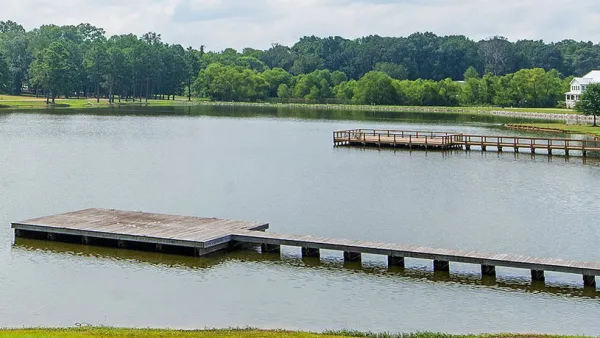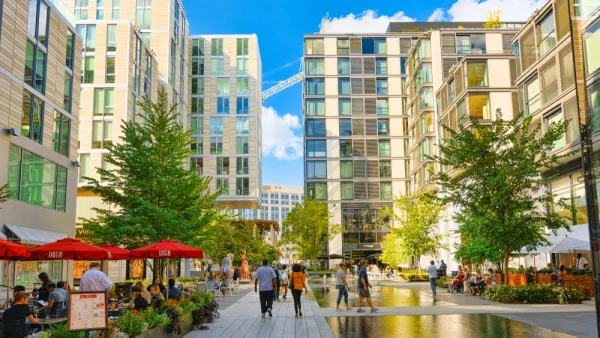"Why did nobody notice it? If these things were so large, how come everyone missed them?" - Queen Elizabeth, on the global credit crunch. Things are so large in the Vaughan Corporate Centre, an edge city about 20 kilometres northwest of downtown Toronto, that a cross-section of Vancouver's downtown peninsula, from False Creek to Lost Lagoon, could fit within five of its blocks. There's a street named Colossus, leading to a cineplex of the same name. The overpass and ramps of the adjacent freeways take up an area the size of the West End. They in turn are surrounded by acres of emptiness, just grass and dirt, awaiting more big boxes, more asphalt.
"Why did nobody notice it? If these things were so large, how come everyone missed them?" - Queen Elizabeth, on the global credit crunch.
Things are so large in the Vaughan Corporate Centre, an edge city about 20 kilometres northwest of downtown Toronto, that a cross-section of Vancouver's downtown peninsula, from False Creek to Lost Lagoon, could fit within five of its blocks.
There's a street named Colossus, leading to a cineplex of the same name. The overpass and ramps of the adjacent freeways take up an area the size of the West End. They in turn are surrounded by acres of emptiness, just grass and dirt, awaiting more big boxes, more asphalt.
This is a landscape built by and for civil engineers. It looks primarily designed to handle snow: wide roads, wider shoulders, lots of space to pile the stuff. It's car-dependent, of course, and high carbon. Wasteful. Hostile. And very vulnerable.
It could all be bulldozed tomorrow and it wouldn't be missed. Its designers and builders, private and public, have produced a place that no one likes very much.
There are similar places all across the Greater Toronto Area north of Steeles Avenue - the so-called 905 Belt, after the area code - stretching in a band from the Pearson Airport to Markham. (Taxi drivers took me twice by mistake to Markham rather than Vaughan, and I couldn't tell the difference.)
One feels free to dump on the Vaughan Corporate Centre because, in truth, Vaughan doesn't much like it either. In fact, they - the owners, the developers, the city and province - hope to more or less bulldoze it and try again. The impetus for change is the extension of the Toronto subway, at a cost of billions, in an attempt to tie this amorphous entity into the city, and to make it a place, much more urban, that people might actually care about.
In the last decades of the 20th century, when the provincial government discarded the kind of controls that had made Toronto one of North America's most enviable cities, suburban growth blew past the borders of the Metropolitan area and sprawled its way north. A time before sustainability was taken seriously, when money was easy, oil was cheap, and expected to stay that way.
Ultimately unconstrained growth generated its own backlash, justifying a freeze on development and the introduction of planning concepts, like smart growth, that had been ignored heretofore. With a change in provincial government came a change in planning emphasis: namely, 'intensification' - using existing developed land to accommodate growth - while at the same saving open space and creating de-facto urban-growth boundaries. Familiar stuff in Portland and Vancouver, but contentious in the Greater Golden Horseshoe.
The Ontario government is proud of its growth plan, now called "Places to Grow," formalized in 2006. New urbanist Peter Calthorpe - who calls it was of the best frameworks for regional planning he has ever seen - is working on an urban-centre plan for another asphalt desert where Yonge Street meets the 407 toll road. And this time, even the developers think its a good idea.
Perhaps Vaughan was a necessary failure - so large it couldn't be missed. But it's unfortunately too far away to be a lesson for the Lower Mainland. Under provincial direction, we too are proceeding with our freeway and arterial widenings, the same big boxes, the same asphalt deserts at the interchanges.
The Queen might wonder, why didn't we notice?
[For a comlete illustrated version of this column, go to http://www.pricetags.ca/pricetags/pricetags106.pdf.]

Analysis: Cybertruck Fatality Rate Far Exceeds That of Ford Pinto
The Tesla Cybertruck was recalled seven times last year.

National Parks Layoffs Will Cause Communities to Lose Billions
Thousands of essential park workers were laid off this week, just before the busy spring break season.

Retro-silient?: America’s First “Eco-burb,” The Woodlands Turns 50
A master-planned community north of Houston offers lessons on green infrastructure and resilient design, but falls short of its founder’s lofty affordability and walkability goals.

Test News Post 1
This is a summary

Analysis: Cybertruck Fatality Rate Far Exceeds That of Ford Pinto
The Tesla Cybertruck was recalled seven times last year.

Test News Headline 46
Test for the image on the front page.
Urban Design for Planners 1: Software Tools
This six-course series explores essential urban design concepts using open source software and equips planners with the tools they need to participate fully in the urban design process.
Planning for Universal Design
Learn the tools for implementing Universal Design in planning regulations.
EMC Planning Group, Inc.
Planetizen
Planetizen
Mpact (formerly Rail~Volution)
Great Falls Development Authority, Inc.
HUDs Office of Policy Development and Research
NYU Wagner Graduate School of Public Service





























